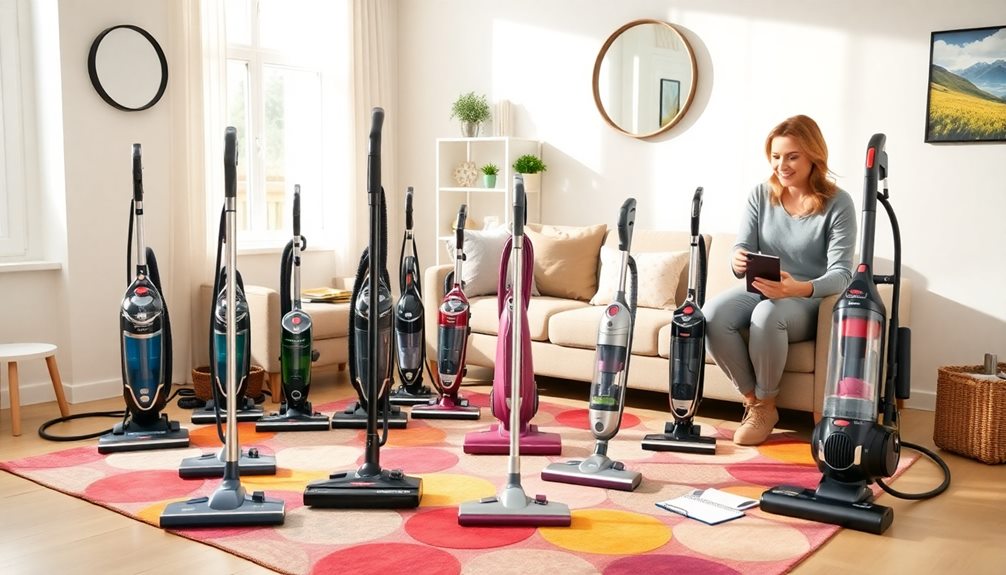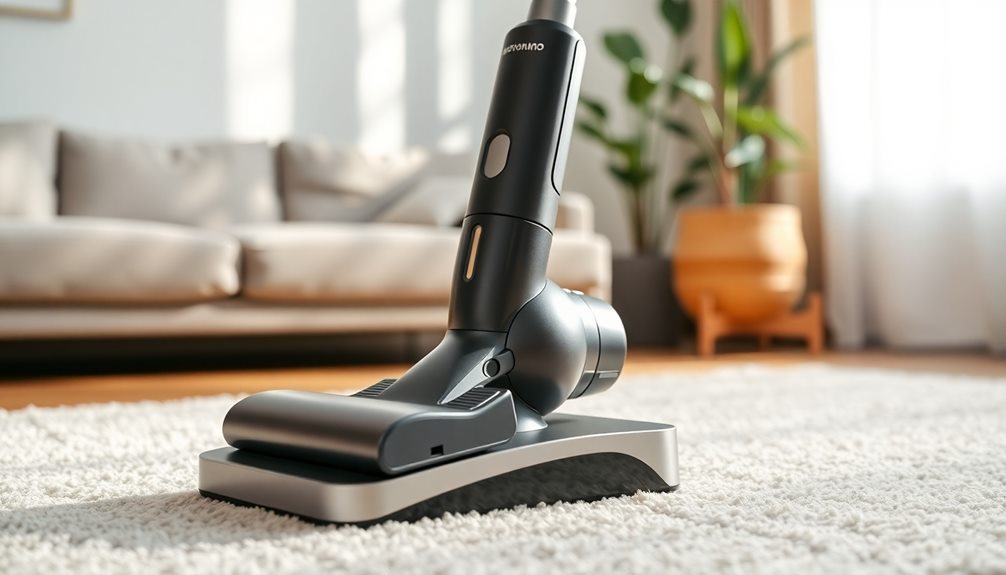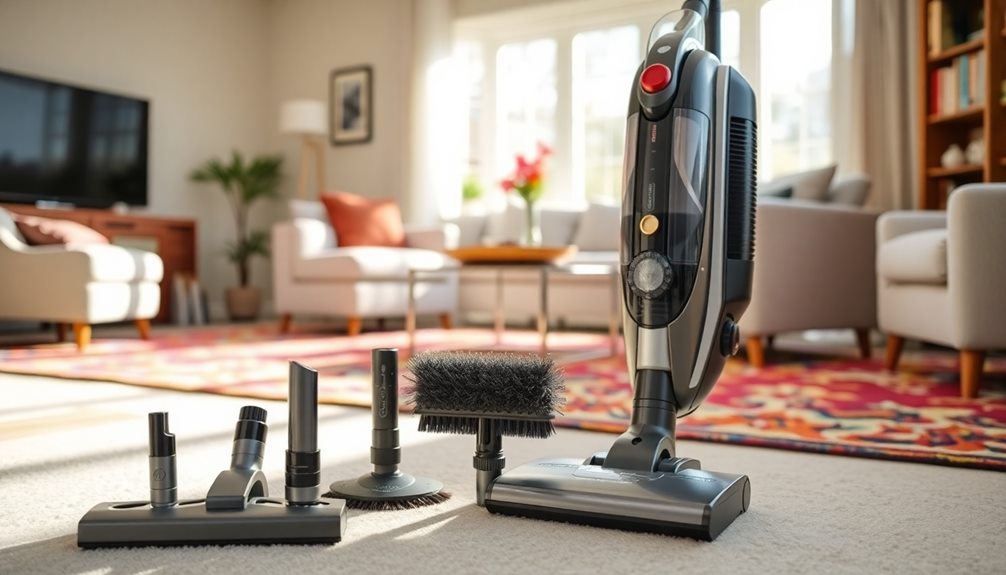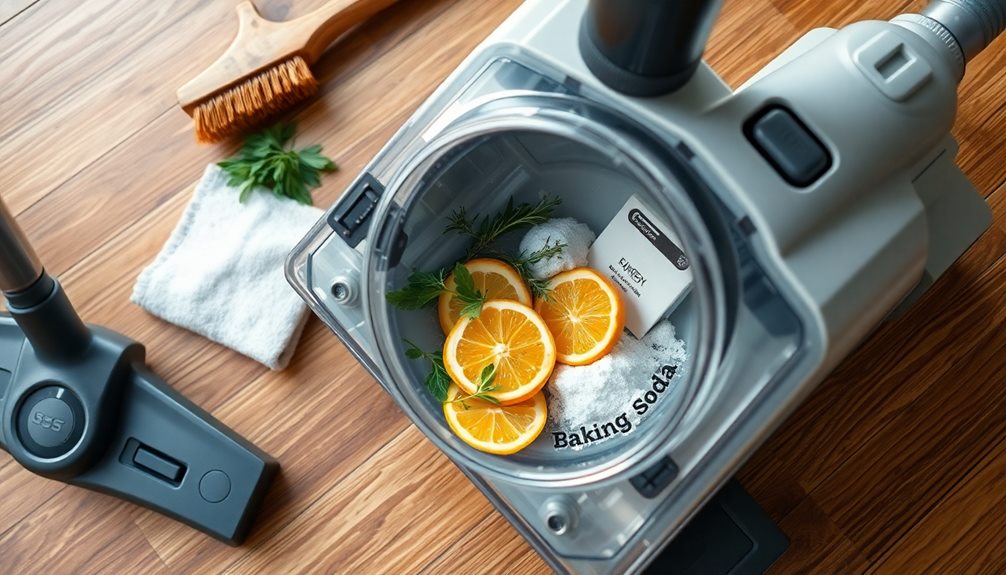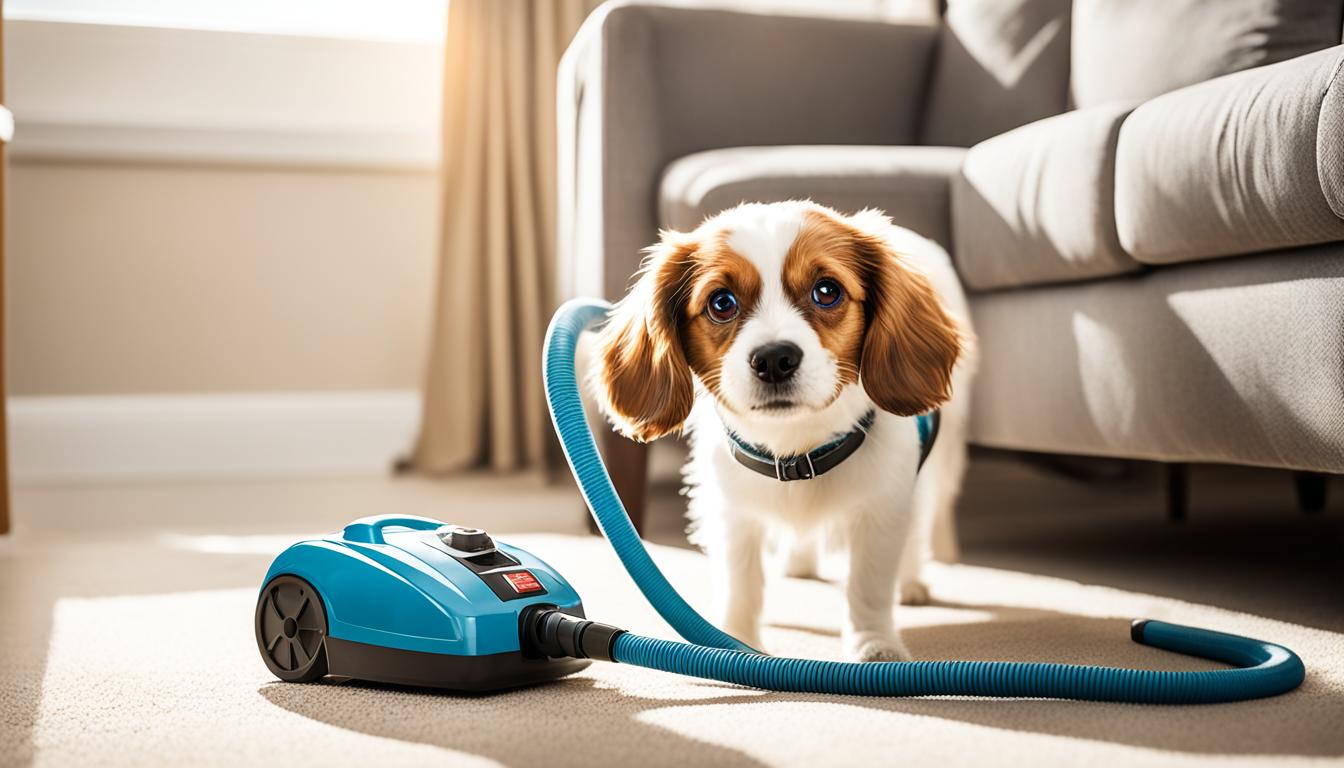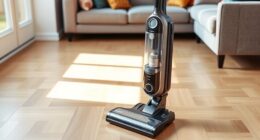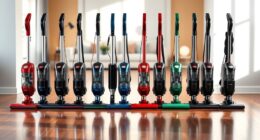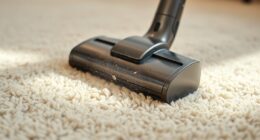To rate vacuum cleaners effectively, focus on key criteria like performance across different surfaces, suction power, and filtration efficiency. Evaluate how well each model handles bare floors and carpets, and check for advanced features like HEPA filters for better air quality. Don't forget to take into account ease of use, noise levels, and user feedback for real-world insights. Also, look at budget-friendly options and maintenance needs to guarantee long-term satisfaction. By examining these aspects, you can find the best vacuum for your needs and preferences, and there's more to discover about the nuances of vacuum selection.
Key Takeaways
- Evaluate performance on various surfaces, including bare floors, low-pile carpets, and high-pile carpets for effective cleaning efficiency.
- Assess suction power by checking the motor strength and airflow, aiming for at least 100 CFM for effective dirt pickup.
- Consider the filtration system's efficiency, prioritizing models with HEPA filters for better indoor air quality and allergen reduction.
- Review ease of use features, such as weight and maneuverability, to enhance the overall cleaning experience.
- Check noise levels; quieter vacuums (60-77 dB) provide a more pleasant cleaning environment.
Key Rating Criteria
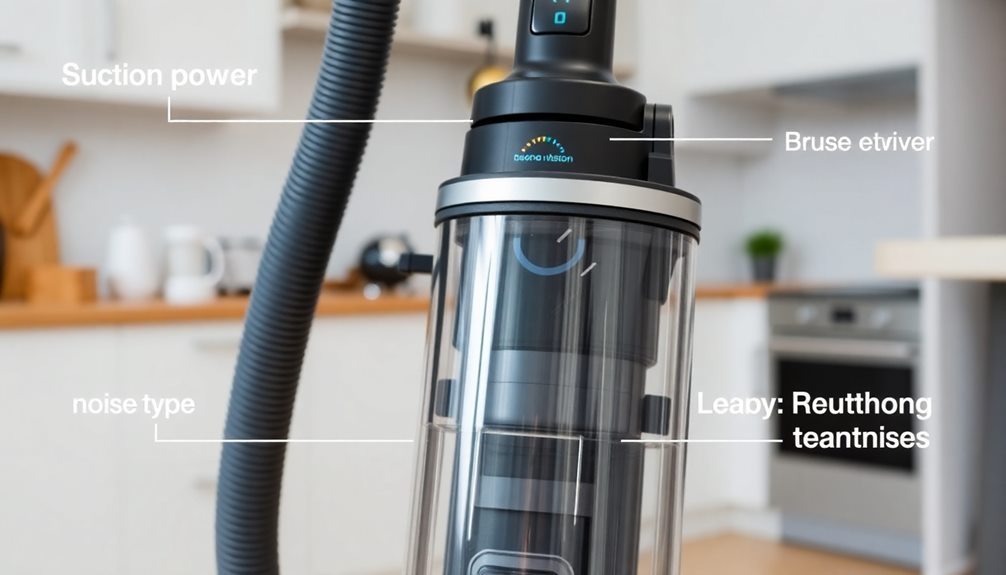
When rating vacuum cleaners, you should focus on several key criteria that directly impact performance and user satisfaction.
First, evaluate the performance on various surfaces, including bare floors, low-pile carpets, and high-pile carpets. A powerful motor and effective suction power are essential for picking up dust and debris efficiently. Additionally, consider how well the vacuum performs in different cleaning challenges such as managing pet hair and dust, as this can greatly affect your choice.
Next, consider the filtration system efficiency. Models with HEPA filters can trap 99.97% of particles as small as 0.3 microns, making them ideal if you suffer from allergies.
Ease of use is another vital factor; lightweight vacuums with good maneuverability make cleaning more manageable. Keep an eye on cord length for corded models, as longer cords can enhance your reach.
Furthermore, examine the capacity and maintenance requirements. A larger dustbin or bag means you won't have to empty or change it as often, which is a time saver.
Finally, don't overlook noise levels. Quieter models, typically ranging from 60 to 77 dB, can make your cleaning experience more pleasant.
Performance Metrics

When evaluating a vacuum cleaner's performance, you'll want to focus on cleaning efficiency, filtration systems, and how well it works on different surfaces.
A vacuum that excels in these areas not only improves your cleaning routine but also guarantees a healthier home environment.
For instance, models with advanced filtration systems can greatly reduce allergens in your space, making them ideal for allergy sufferers.
Cleaning Efficiency Assessment
Cleaning efficiency is vital for choosing the right vacuum cleaner, and performance metrics play a considerable role in this assessment.
To evaluate a vacuum's cleaning efficiency, consider these key performance indicators:
- Airflow: Look for a minimum airflow of 100 CFM. This measurement indicates how effectively the vacuum can pick up dirt and debris from surfaces. Many top-rated vacuums, such as those from best rated vacuums, excel in this area with powerful suction capabilities.
- Sealed Suction: A sealed suction rating of 90 inches or more is essential, especially for carpets. This metric reflects the vacuum's ability to lift embedded dirt and pet hair.
- Debris Pickup: Check user feedback and lab tests on how well the vacuum performs on various floor types, including bare floors and different carpet piles.
Another important aspect of cleaning efficiency is the filtration capability.
While we won't explore HEPA filters' importance just yet, remember that a vacuum's effectiveness in trapping particles can greatly impact overall air quality.
Filtration System Importance
A vacuum cleaner's filtration system plays a pivotal role in maintaining a healthy home environment, especially for allergy sufferers. The filtration performance directly impacts indoor air quality, as a poor system can release dust and allergens back into the air. A certified HEPA filter can remove 99.97% of particles as small as 0.3 microns, which is essential for effective filtration.
To help you evaluate different vacuum cleaners, here's a comparison of key filtration features:
| Filter Type | Filtration Efficiency | Ideal for Allergy Sufferers |
|---|---|---|
| Certified HEPA | 99.97% of 0.3 microns | Yes |
| True HEPA | 99.97% of 0.3 microns | Yes |
| Absolute HEPA | 99.97% of 0.3 microns | Yes |
| S-Class Filters | Similar to HEPA | Yes |
| HEPA-like Filters | Lower efficiency | No |
When choosing a vacuum, also consider airflow (CFM) and sealed suction (water lift), as these metrics indicate how well the vacuum maintains suction power while utilizing its filtration system effectively, especially when cleaning carpets.
Surface Compatibility Evaluation
Understanding how well a vacuum cleaner performs on different surfaces is key for finding the right one for your home. Evaluating surface compatibility helps you assess its cleaning efficacy based on various surface types. Here are three important factors to take into account:
1. Debris Pickup: Check how effectively the vacuum can handle different debris, from large particles to fine dust and pet hair. Performance can vary greatly across surface types, making it essential to choose a model that excels in your specific environment.
For instance, some vacuums are specifically designed for best vacuums for dust removal in 2024, ensuring superior dust and allergen elimination.
2. Specialized Features: Look for vacuums that offer features like brush rolls or suction adjustments tailored for specific surfaces. These can greatly enhance performance on carpets versus hard floors.
3. User Feedback: Analyze reviews to understand real-world experiences regarding surface compatibility. User feedback often reveals insights beyond lab testing, providing a clearer picture of vacuum performance across different flooring.
Additionally, take into account performance ratings, such as the Dyson V15 Detect scoring 7.8 for bare floors and low-pile carpets. This gives you a benchmark for gauging overall versatility in cleaning.
Types of Vacuum Cleaners
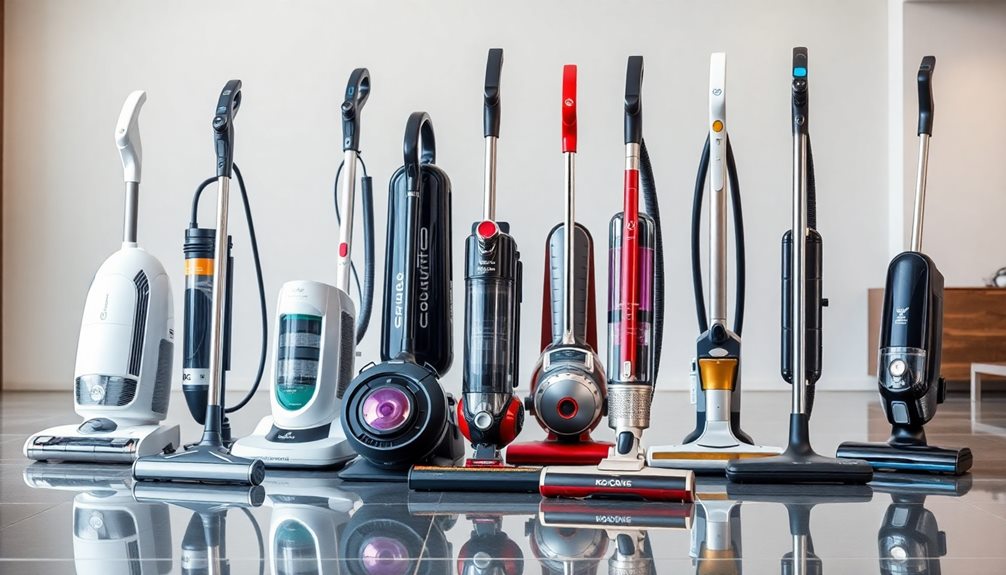
When it comes to choosing a vacuum cleaner, knowing the different types available can make all the difference.
Upright vacuums are popular in the U.S. and Great Britain, featuring revolving brush rolls for effective carpet cleaning and powerful suction. If you need versatility, canister vacuums are your best bet. They excel at floor cleaning across various surfaces, including carpets and stairs.
For quick cleanups, stick vacuums are lightweight and easy to maneuver. Many of them even convert into handheld models, offering added convenience for smaller spaces.
When considering your options, think about bagged vs. bagless models. Bagged vacuums are better for allergy sufferers thanks to their hygienic dirt disposal, while bagless models typically have lower short-term costs but may require more frequent filter maintenance.
Robot vacuums, on the other hand, are designed for low-intensity cleaning tasks. They operate independently and work well on hard floors and low-pile carpets, although they're not suitable for heavy-duty cleaning.
With these options in mind, you can choose the vacuum that best suits your needs and lifestyle.
Maintenance and Care
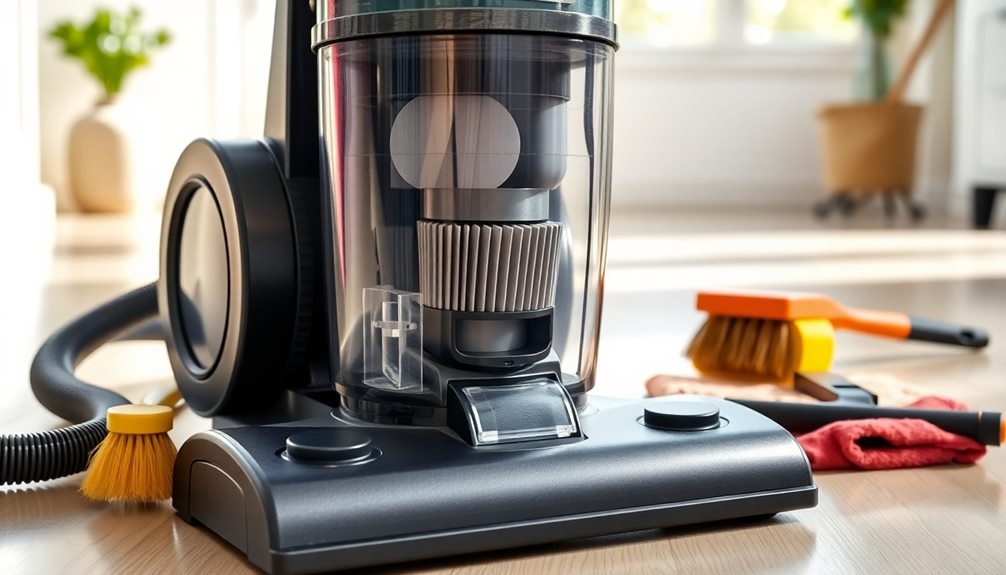
Maintaining your vacuum cleaner is vital for keeping it running efficiently and extending its lifespan. Regular care can greatly improve suction and overall performance. Here are three key maintenance tasks you should prioritize:
- Clean or Replace Filters: Follow the manufacturer's guidelines to guarantee ideal filtration efficiency. Dirty filters can hinder suction and lead to poor cleaning performance.
- Inspect Hoses and Wands: Check for clogs and debris at least once a month. This inspection not only maintains airflow but also assures your vacuum operates at peak efficiency.
- Care for Brushrolls: After each use, remove tangled hair and debris from the brushrolls. This simple cleaning task prevents damage and maintains effective cleaning capabilities.
Additionally, store your vacuum in a clean, dry place to prevent moisture damage.
Following the manufacturer's maintenance schedule is critical, as it may include tasks like belt replacement and internal cleaning.
Budget Considerations
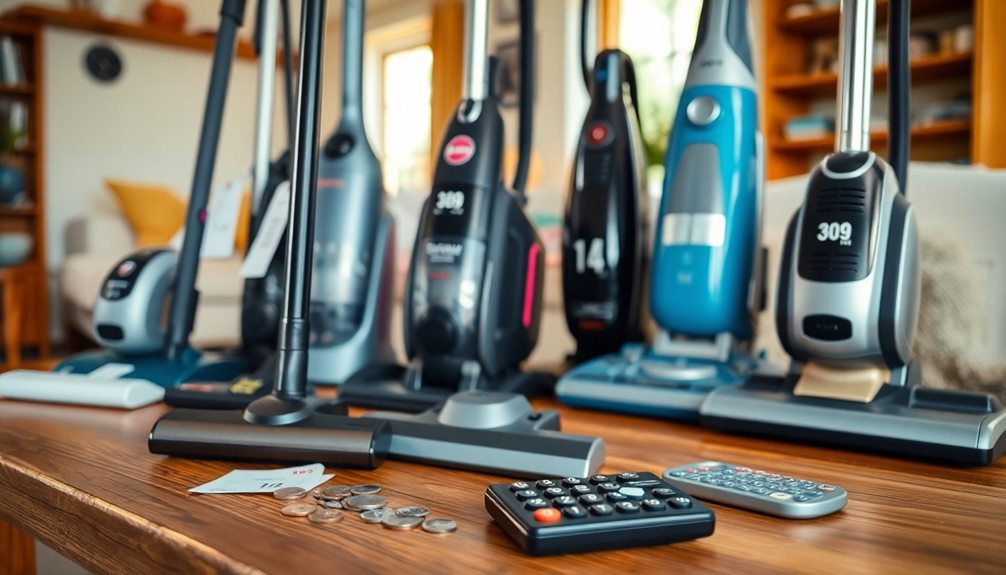
When you're shopping for a vacuum cleaner, it's crucial to find options that fit your budget without sacrificing quality.
Keep an eye on price trends and seasonal sales to snag a great deal, as this can help stretch your dollar further.
Evaluating long-term value will also guarantee you invest wisely, balancing affordability with performance and durability.
Affordable Vacuum Options
Finding an affordable vacuum cleaner that fits your needs doesn't have to be an intimidating task. You can discover great options that provide effective cleaning solutions without breaking the bank.
Here are three budget-friendly vacuum options to evaluate:
- Bissell FeatherWeight Stick Vacuum – Priced as low as $33, this lightweight vacuum is perfect for quick clean-ups and small spaces.
- Eureka Mighty Mite Canister – This reliable canister model is typically under $100 and offers good suction for various surfaces.
- Wyze Cordless Vacuum – Often found for under $150, this cordless model includes onboard HEPA filters and decent battery life in ECO mode.
While these budget vacuums help reduce short-term ownership costs, keep in mind that they may require more frequent maintenance and replacement than higher-end models.
To maximize your savings, look out for seasonal sales, like Black Friday or Amazon Prime Day, where you can snag discounts on vacuum cleaners.
With the right research and timing, you can find affordable vacuum options that meet your cleaning needs without overspending.
Price Trends Insights
Understanding price trends is vital for making informed decisions about vacuum cleaner purchases. The price point of vacuum cleaners varies greatly, typically ranging from under $100 for basic models to over $1,000 for high-end canister vacuums.
Quality and features greatly influence costs, so it's important to identify what you need. If you're on a budget, look for budget-friendly options like the Wyze Cordless Vacuum, usually priced under $150. Mid-range models, such as the Shark Stratos Cordless, often fall between $300 and $400.
Keep in mind that higher-priced vacuum cleaners usually come with advanced features like HEPA filtration and self-cleaning capabilities, which enhance performance and longevity.
To snag a great deal, take advantage of seasonal sales events like Black Friday and Amazon Prime Day, which often provide considerable discounts. Also, regular price research is key, as prices fluctuate frequently.
Evaluating Long-Term Value
How can you guarantee that your vacuum cleaner purchase is a wise investment? To evaluate the long-term value, consider several key factors that influence the overall cost. While a lower initial purchase cost might seem appealing, it's essential to look beyond that. Here's what to keep in mind:
- Expected Lifespan: High-quality vacuums typically last around eight years. Investing in a durable model can yield significant savings over time.
- Total Cost of Ownership: Assess maintenance and replacement parts. A cheaper vacuum may incur higher long-term costs due to frequent repairs or parts replacement.
- Warranty Offerings: Strong warranties often indicate better quality. A longer warranty can save you money on future repairs, enhancing the vacuum's long-term value.
Also, factor in energy efficiency and operating costs. Models with lower power consumption can reduce your electricity bills over their lifespan.
Finally, keep an eye on price trends; shopping during events like Black Friday can help you snag high-quality vacuums at a great price.
Consumer Reviews and Feedback

Consumer reviews serve as invaluable resources when evaluating vacuum cleaners, offering insights that reflect real-world performance. By diving into consumer feedback, you can gauge user satisfaction across various models and scenarios.
You'll find details on ease of use, suction power, and maintenance requirements, helping you identify which vacuum suits your needs best. Many reviews provide performance metrics based on specific cleaning situations, allowing you to compare effectiveness across different surfaces and debris types.
Pay attention to high ratings for reliability and owner satisfaction, as these indicators suggest long-term durability and effectiveness—important considerations for your purchase. Additionally, some vacuums are evaluated through a combination of lab testing and consumer surveys, giving you a thorough understanding of performance.
This approach guarantees you're making an informed decision based on both expert and real-world evaluations. When you analyze consumer reviews, you're not just reading opinions; you're gathering essential information on how well a vacuum cleaner will perform in your home, helping you choose a model that meets your expectations for cleanliness and convenience.
Frequently Asked Questions
How Do You Rate a Vacuum Cleaner?
To rate a vacuum cleaner, you'll assess its performance on different surfaces, check its filtration system, consider user feedback, and evaluate features like weight and attachments. This thorough approach guarantees you make an informed choice.
How Do You Measure Vacuum Cleaner Performance?
You measure vacuum cleaner performance by evaluating its suction power, airflow, and filtration efficiency. Test it on various surfaces, noting how well it picks up debris and handles different cleaning scenarios to determine overall effectiveness.
What Is Good Suction Power for a Vacuum?
Think of suction power as the engine of a vacuum; it drives effective cleaning. Aim for 200-300 air watts for household tasks, and consider higher values if you're tackling pet hair or deep carpet cleaning.
What Is the #1 Best Vacuum?
If you're looking for the best vacuum, you can't go wrong with the Dyson V15 Detect. Its innovative features, strong performance, and user satisfaction ratings make it a top choice for tackling dirt and allergens effectively.
Conclusion
In summary, rating vacuum cleaners is like maneuvering through a maze; it requires careful consideration of various factors to find your ideal match. By focusing on key rating criteria, understanding performance metrics, and exploring different types, you can make an informed choice. Don't forget to factor in maintenance and budget, as well as consumer reviews, to guarantee you're investing wisely. With the right approach, you'll discover a vacuum cleaner that meets your needs and keeps your space spotless.
